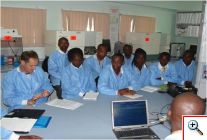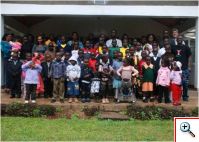USAMRU-K Kericho Field Station (U.S. Military HIV Research Program)
 The USAMRU-K HIV program is located in the South Rift Valley Province at the KEMRI/USAMRU-K Clinical Research Center, Kericho, Kenya. The USAMRU-K HIV program’s primary mission is contributing to the development of a globally effective HIV-1 vaccine to protect U.S. military service members, allied forces, and the world community through evaluating HIV vaccine candidates in clinical trials.
The USAMRU-K HIV program is located in the South Rift Valley Province at the KEMRI/USAMRU-K Clinical Research Center, Kericho, Kenya. The USAMRU-K HIV program’s primary mission is contributing to the development of a globally effective HIV-1 vaccine to protect U.S. military service members, allied forces, and the world community through evaluating HIV vaccine candidates in clinical trials.
Kericho Field Station Program Milestones.
• 2001 – First PMTCT program established in the South Rift Valley Province (now the second largest in Kenya).
• 2003 – Only prospective HIV cohort study in Kenya.
• 2004 – Boston University/KEMRI collaboration published landmark study for East Africa demonstrating the impact of HIV on labor productivity.
• 2004 – U.S. DoD/PEPFAR brings HIV treatment to Kericho area/South Rift Valley Province and Kenya Department of Defense.
• 2005 – Kericho Field Station opens first integrated Tb/HIV clinic in region.
• 2006 – Phase III, NIH-sponsored multi-centered therapeutics study opens that ultimately guided PMTCT policy in sub-Saharan Africa.
• 2006 – Phase I/II HIV vaccine study opens. The study is the only HIV vaccine study outside of Nairobi and the largest in Kenya’s history.
• 2007 – Phase I/II HIV vaccine study closes and marked with success and attention to Good Clinical Practices (GCP) and community engagement.
• 2008 – USAMRU-K Clinical Research Center laboratory becomes the first and only College of American Pathologists (CAP) accredited lab in Kenya. 2008 – PEPFAR enrollment surpasses 30,000 Kenyan’s in the newly opened HIV clinics. Approximately 15,000 started ARTs; 200,000 women received PMTCT services; and over 100,000 individuals received HIV testing and counseling.
• 2008 – Kericho Field Station CRS recognized along with Eldoret CRS under newly formed USMHRP CTU.
• 2008 – HJFMRI formally part of the HIV program.
• 2009 – IRIS is first IDCRP international HIV study opened at the Kericho Field Station.
• 2009 – MHRP mission critical “High Risk Cohort Study” to open in 2nd/3rd Quarter.
• 2009 – MHRP Kericho CRS to propose HIV-Malaria concept package to ACTG and DAIDS leveraging upon and introducing key research opportunities to the Kisumu Field Station.
• 2009 – CLADE study to open in 3rd/4th Quarter.
• 2009 – Kericho Field Station preparing for second HIV vaccine study.
• 2009 – Construction and operation of new state of the art microbiology laboratory.
• 2010 – USAMRU-K Clinical Research Center laboratory reaccredited by the College of American Pathologists (CAP).
• 2010 – RV186 OCTANE study results published in NEJM (Lockman et al including Sawe, Shaffer, and Siika) with approximately 10 additional manuscripts published with Kericho lead or co-authors
• 2010 – By year’s end, PEPFAR anticipated achievements: 53,000 Kenyans in newly opened HIV clinics, 22,000 starting ART, 355,000 women receiving PMTCT services, and 325,000 receiving HIV counseling and testing
• 2011 – second vaccine study (RV262, DNA/MVA with MVA being WRAIR product) to open 3-4th qtr
Current and Upcoming Protocols
• Vaccine: HIV Cohort Study; Phase I/II Vaccine Study; High-Risk Cohort Study; Phase I/II DNA-MVA.
• Therapeutic: OCTANE Phase III; IRIS; CLADE (PEPFAR PHE).
• Other Cohort: ART Labor Productivity; ART Economic Outcomes; ART Costs and Outcomes.
• Other: Qualitative/Oral Birth Control Focus Group Study and Tb/HIV PEPFAR Clinic Review.
